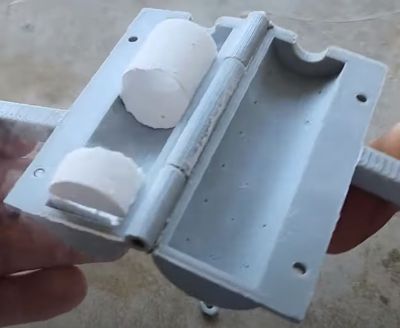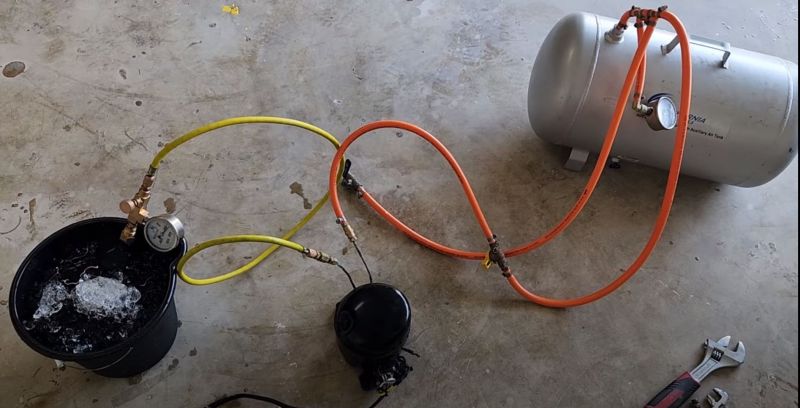Along the road to developing his own cryocooler to produce liquid nitrogen, there are a number of interesting rabbit holes [Hyperspace Pirate] has found himself taking a look at. For example, using dry ice for a pre-cooling stage and subsequently wondering what it’d take to make this dry ice oneself.
Getting the CO2 required for the dry ice is the easy part, requiring nothing more complicated than baking soda and a suitable acid (like hydrochloric acid). The other options to gather CO2 include using yeast, capturing the gas from the air people breathe out, calcium hydroxide, etc., none of which are as easy or convenient.
 The acid is mixed with the baking soda, with the produced gas led through a bubbler and subsequent dehumidification stage before being collected. For the more involved part of getting dry ice, a bit more science is needed. First, a compressor is used to get pressurized CO2 into a previously evacuated tank at 160 psi (~12 bar). For the next phase the compressed gas has to be compressed further so that it condenses into a liquid. This involves a second compressor stage and a repurposed paintball tank. At the needed pressure of 1000 psi (69 bar), safety is essential.
The acid is mixed with the baking soda, with the produced gas led through a bubbler and subsequent dehumidification stage before being collected. For the more involved part of getting dry ice, a bit more science is needed. First, a compressor is used to get pressurized CO2 into a previously evacuated tank at 160 psi (~12 bar). For the next phase the compressed gas has to be compressed further so that it condenses into a liquid. This involves a second compressor stage and a repurposed paintball tank. At the needed pressure of 1000 psi (69 bar), safety is essential.
With liquid carbon dioxide in the paintball tank, all it takes at this point is to turn the tank upside-down to get the liquid part near the exhaust valve and crank it open. Capturing the dry ice at this point is another fascinating challenge, which was partially solved by a 3D printed mold, with plenty of room for improvement still.
Given the cost and effort involved in producing it, just buying dry ice at the local store looks like it’s still the way to go for your Halloween fog machine this year. But it’s a fascinating experiment regardless, especially since it actually produced results — unlike some of the attempts we’ve covered previously.
















The easy way, attach a pillow case to a CO² fire extinguisher cone. [ As per the warning label, don’t hold the cone, unless you want freezer burn. ] Dump the contents into the pillow case. The rapid expansion of the gas will case it to get very cold and form the dry ice you’re looking for.
That’s how we did it in high school.
The administration was deeply disappointed in us for emptying all the 3rd floor fire extinguishers though.
I guess there’s always a trip to the local pub to beg for a gas bottle. Cheaper than welding gas.
Maybe this is a silly question, but wouldn’t it be more efficient to just use the liquid CO2 to directly cool his cryo-cooler than utilize dry ice?
Liquid CO2 isn’t cold on its own; it’s liquid because it’s at a very high pressure. The evaporation as the pressure drops causes its temperature to drop to the point that some of it freezes into dry ice; it’s only at this point that it becomes cold enough to be useful for cooling.
Well yes, you obviously need to let it do a phase change for it to have any cooling effect. But why not pass it through a fixed orifice to let that pressure drop and phase change take place and use that as the cooling method? It seems like that would be less wasteful of the CO2 produced and maybe even have better cooling capacity.
Indeed, letting the liquid CO2 evaporate in a heat exchanger seems more logical then using the solid stuff. It would also be relatively easy to recapture the evaporated CO2 in a humongous plastic bag and recompress it later, or make it a directly closed cycle.
It’s a delicate balancing act, because the CO2 can still form dry ice inside the evaporator, which would block it and make it explode to pieces.
Yes he could. He could also use liquid N2 to liquify O2 and liquified He to liquify his N2. But a cryocooler should be able to produce cryogenic temps without the need of freezing agents.
Liquid helium at atmospheric pressure is so cold that when you transfer it, pale blue drops of condensed liquid oxygen drip off the transfer line. It’s really cold immmau be way off but I remember 4K. If this dude is struggling to get solid CO2 he’s gonna have a bear of a time gettin other cryogenic gases.
In high school, the chemestry teacher worked really hard to be able to make dry ice. He had to wrangle with the gas vendor to supply a CO2 tank with a drop tube and then he had to get funding to buy the ice generator device itself. I remember the day the last part was delivered. It was advanced chemestry and the class just stopped when it arrived. He tore open the wrappings like a small child on xmas. The rest of the period was spent making dry ice and digging through the store room to find fun things to freeze.
That’s the kind of joy a teacher can show that will infect their students and help them love the subject, too. “A good time was had by all.”
Oh! The next day in physics, we made a cloud chamber and everyone got to *see* radiation. It made all the cost and effort completely worth it to demonstrate that concept so concretely.
We made dry ice ourselves. We found the best way to do it was to direct the flow of liquid CO2 through a textile, and the best we found was the pocket of the lab coat.
Wondering if Soda Stream cartridges would work as an easily available CO2 source.
Much cheaper to just get a 5 (or 10lb) cylinder from your local welding supply. You can also get an adapter to refill your Sodastream from said cylinder for peanuts.
In the air liquefying systems I’ve played with (a friend built one) the CO2 comes free out of the first stage, because after your system gets cold enough all the water freezes out and chokes the recirculative, then the CO2 does the same thing.
“all it takes at this point is to turn the tank upside-down to get the liquid part near the exhaust valve and crank it open.”
At 1,000PSI one would think that the better option would be to “crack” it open, not crank on it… but ooookay.
Here we go…
(what could possibly go wrong?)
:)
damn thats cool,and solid
bootstraping liquid nitrogen
the closest I have come to cryo stuff,is removing the saftey
valve from a propane tank,opening the valve till it blows off
and pouring out liquid propane and putting
shafting in it to get press fit bearings(warm)to just drop on
its one of those extra danger things where its possible to get frost bite,burnt,pinched and blown up,all at once
> its one of those extra danger things where its possible to get frost bite,burnt,pinched and blown up,all at once
Sounds like a good time to me, but I’m no stranger to explosives, stitches and skingrafts. :D
Does filling up the LNG tank of a car count when the pipe/hose between tank and inlet is leaky -> dripping liquid ;-) LNG on the ground where it instantly evaporates?
Your local welding supply house will be glad to rent you a CO2 cylinder. I have them refill mine all the time for beer stuff. It’s like $20 for a 5lb fill.
And yeah in the lab we had a dry ice maker. It was a hockey puck sized canvas bag that you put on the outlet of the big cylinder, open it up and presto. A cake of dry ice in no time. For quantity we had deliveries.
Also your grocery store probably had a big cryo cooler in the front that sells pellets and blocks for very reasonable fees.
Or, that $20 will buy you 40 lb of dry ice here.
Isn’t that, like, what I said? You can buy at grocery store.
Acid, very cold stuff, compressed gas, sounds fun… Extra points for trying with flammable gas… (DON’T DO THIS!)
The same as alot of make it at home stuff goes you CAN make it at home but it will cost MUCH MUCH more than finding a source of ready made. Conversion effeceintcy is super low with co2 gas or liquid to solid dry ice, like in less than a few ounces of dry ice snow per pound of gas used and thats starting from already made liquid co2, compressors use electricity and making enough gas to compress, purifying that gas and ending up with useable dry ice is a super head ache and expensive.
I found Meijer store sells dry ice in 4 or 5 pound blocks for under 2 bucks a pound here in illinois so for the cost of a compressor (needs a scba type gas compressor like fills diving tanks about 3 grand ! ) you COULD BUY 1500 POUNDS OF DRY ICE!! Enough to make alot of frozen stuff!